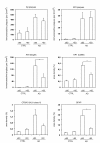Neuroinflammation in Alzheimer's disease wanes with age
- PMID: 22152162
- PMCID: PMC3248382
- DOI: 10.1186/1742-2094-8-171
Neuroinflammation in Alzheimer's disease wanes with age
Abstract
Background: Inflammation is a prominent feature in Alzheimer's disease (AD). It has been proposed that aging has an effect on the function of inflammation in the brain, thereby contributing to the development of age-related diseases like AD. However, the age-dependent relationship between inflammation and clinical phenotype of AD has never been investigated.
Methods: In this study we have analysed features of the neuroinflammatory response in clinically and pathologically confirmed AD and control cases in relation to age (range 52-97 years). The mid-temporal cortex of 19 controls and 19 AD cases was assessed for the occurrence of microglia and astrocytes by immunohistochemistry using antibodies directed against CD68 (KP1), HLA class II (CR3/43) and glial fibrillary acidic protein (GFAP).
Results: By measuring the area density of immunoreactivity we found significantly more microglia and astrocytes in AD cases younger than 80 years compared to older AD patients. In addition, the presence of KP1, CR3/43 and GFAP decreases significantly with increasing age in AD.
Conclusion: Our data suggest that the association between neuroinflammation and AD is stronger in relatively young patients than in the oldest patients. This age-dependent relationship between inflammation and clinical phenotype of AD has implications for the interpretation of biomarkers and treatment of the disease.
© 2011 Hoozemans et al; licensee BioMed Central Ltd.
Figures


Similar articles
-
Inflammatory pathology markers (activated microglia and reactive astrocytes) in early and late onset Alzheimer disease: a post mortem study.Neuropathol Appl Neurobiol. 2018 Apr;44(3):298-313. doi: 10.1111/nan.12445. Epub 2017 Nov 27. Neuropathol Appl Neurobiol. 2018. PMID: 29044639
-
Apoptosis of astrocytes with enhanced lysosomal activity and oligodendrocytes in white matter lesions in Alzheimer's disease.Neuropathol Appl Neurobiol. 2002 Jun;28(3):238-51. doi: 10.1046/j.1365-2990.2002.00390.x. Neuropathol Appl Neurobiol. 2002. PMID: 12060348
-
Markers of neuroinflammation associated with Alzheimer's disease pathology in older adults.Brain Behav Immun. 2017 May;62:203-211. doi: 10.1016/j.bbi.2017.01.020. Epub 2017 Feb 1. Brain Behav Immun. 2017. PMID: 28161476
-
Does the Interplay Between Aging and Neuroinflammation Modulate Alzheimer's Disease Clinical Phenotypes? A Clinico-Pathological Perspective.J Alzheimers Dis. 2016 May 11;53(2):403-17. doi: 10.3233/JAD-160121. J Alzheimers Dis. 2016. PMID: 27176075 Review.
-
Potential immunotargets for Alzheimer's disease treatment strategies.J Alzheimers Dis. 2013;33(2):297-312. doi: 10.3233/JAD-2012-121222. J Alzheimers Dis. 2013. PMID: 23001712 Review.
Cited by
-
Deciphering the mechanism underlying late-onset Alzheimer disease.Nat Rev Neurol. 2013 Jan;9(1):25-34. doi: 10.1038/nrneurol.2012.236. Epub 2012 Nov 27. Nat Rev Neurol. 2013. PMID: 23183882 Review.
-
Ineffective levels of transforming growth factors and their receptor account for old age being a risk factor for Alzheimer's disease.Alzheimers Dement (N Y). 2019 Dec 9;5:899-905. doi: 10.1016/j.trci.2019.11.007. eCollection 2019. Alzheimers Dement (N Y). 2019. PMID: 31890854 Free PMC article. Review.
-
Brain integrity is altered by hepatic APOE ε4 in humanized-liver mice.Mol Psychiatry. 2022 Aug;27(8):3533-3543. doi: 10.1038/s41380-022-01548-0. Epub 2022 Apr 13. Mol Psychiatry. 2022. PMID: 35418601 Free PMC article.
-
Association of Anemia with Cognitive Function and Dementia Among Older Adults: The Role of Inflammation.J Alzheimers Dis. 2023;96(1):125-134. doi: 10.3233/JAD-230483. J Alzheimers Dis. 2023. PMID: 37742647 Free PMC article.
-
Higher p-Cresol sulfate and tumor necrosis factor (TNF)-α levels are associated with cognitive improvement through increased TNF receptor 2 in individuals with mild cognitive impairment: A cross-sectional mediation analysis.J Alzheimers Dis Rep. 2025 Jul 24;9:25424823251362483. doi: 10.1177/25424823251362483. eCollection 2025 Jan-Dec. J Alzheimers Dis Rep. 2025. PMID: 40727257 Free PMC article.
References
-
- Arends YM, Duyckaerts C, Rozemuller JM, Eikelenboom P, Hauw JJ. Microglia, amyloid and dementia in alzheimer disease. A correlative study. Neurobiol Aging. 2000;21:39–47. - PubMed
-
- Hoozemans JJ, Van Haastert ES, Veerhuis R, Arendt T, Scheper W, Eikelenboom P, Rozemuller AJ. Maximal COX-2 and ppRb expression in neurons occurs during early Braak stages prior to the maximal activation of astrocytes and microglia in Alzheimer's disease. J Neuroinflammation. 2005;2:27. doi: 10.1186/1742-2094-2-27. - DOI - PMC - PubMed
Publication types
MeSH terms
Substances
LinkOut - more resources
Full Text Sources
Medical
Research Materials
Miscellaneous

